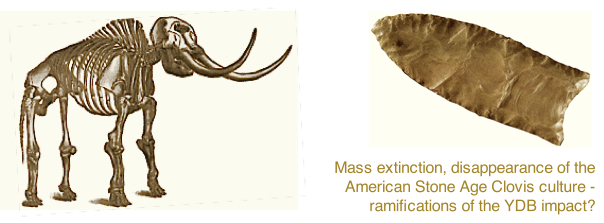… or a “Requiem” for the rejection of the hypothesis?
YDB abbreviates Younger Dryas Boundary. The Younger Dryas stadial signifies a sharp onset of a period of cold climatic conditions in Earth’s history lasting roughly 1,000 years between about 11,000 and 10,000 B.C. at the end of the Pleistocene (the “Ice Age”) and the beginning Holocene.
The causes of this event are controversially disputed, and they are conventionally ascribed to perturbations of North Atlantic circulation. In 2007, a new hypothesis on a giant meteorite impact being reflected by the YDB created a sensation (above all related with the name of Richard Firestone). This postulated impact of a fragmented asteroid or comet over North America/Canada is supposed to have initiated the sudden climatic change, vast wildfires, mass extinctions (including large mammals), destabilization of the Ice Sheet, and the end of the Stone Age Clovis culture. In the years that followed, several independent groups published supporting evidence.
However unsurprisingly in this field of geosciences, oppositions were enormous, and subsequently, many scientific teams were especially occupied to show that this conception could NOT be right. Finally, in the past year these opposing opinions culminated in a paper
The Younger Dryas impact hypothesis: A requiem,
authors: Nicholas Pinter, Andrew C. Scott, Tyrone L. Daulton, Andrew Podoll, Christian Koeberl, R. Scott Anderson, Scott E. Ishman,
in the journal Earth-Science Reviews, Vol. 106, 247-264.
It’s anyone’s guess whether such a “requiem” title is in good style for a scientific article – since a few days ago a new leaf in the discussion has been turned over, and one is tempted to speak of a possible requiem for the requiem. The reputable journal
Proceedings of the National Academy of Science of the United States of America (PNAS)
published the article
Very high-temperature impact melt products as evidence for cosmic airbursts and impacts 12,900 years ago
written by the authors
Ted E. Bunch, Robert E. Hermes, Andrew M.T. Moore, Douglas J. Kennett, James C. Weaver, James H. Wittke, Paul S. DeCarli, James L. Bischoff, Gordon C. Hillman, George A. Howard, David R. Kimbel, Gunther Kletetschka, Carl P. Lipo, Sachiko Sakai, Zsolt Revay, Allen West, Richard B. Firestone, and James P. Kennett, from a whole range of in part highly respected institutions.
The complete article may be downloaded HERE.
The article describes the finds and analyses of microspherules and slag-like objects from overall 18 various places in North America, Europe and Asia where dated YDB horizons had be sampled. The origin of these particles, which are lacking below and above the horizon in such a concentration, is according to the authors incompatible with human discharge, volcanism, on site geologic processes, or primary cosmic delivery. Instead, the only explanation is a deposition of ejecta of extraterrestrial impacts, and the enormous distribution proves to be in agreement with multiple projectiles.
With some certainty, this is not the final chapter of the discussion about the YDB, and the story manifests how short-lived science can be and how hastily a requiem is celebrated sometimes.
We remember moreover the severe scientific controversies und feuds related with the mass extinction (including the dinosaurs) at the Cretaceous-Tertiary boundary and the new idea of Alvarez and co-workers postulating a cosmic catastrophe as a trigger factor (the Chicxulub impact). Also then, many groups were arguing against the new hypothesis (now commonly accepted) using MISSING evidence in the layers they had been studying, and particularly many paleontologists needed again and again to be reminded by Prof. Alvarez that, e.g., missing fossils are NOT a criterion for dating purposes and are barely suited for any argumentation.
That’s the way things are in science that missing evidence basically is of poor conviction. Convincing evidence is given by positive results provided they are consistent with the current state of scientific knowledge.
Not to forget the Chiemgau impact completely: We experienced the fugacity of claims in science exemplarily in connection with a TV documentary film on the “Chiemgau comet” broadcasted in 2006 by the German ZDF in its Terra X series. After the broadcast the Institute of Planetology of the University of Münster (Prof. Jessberger) vociferously and analogously let out: “As for comets we know everything”, with that said trying to slaughter the Chiemgau impact hypothesis. Only a few (!) months later, when samples of the Stardust mission had been returned, NASA experts stated: We are at the beginning of a change of paradigm in the science of comets; we must give it a serious new consideration where the comets are coming from and of what they are composed.



































